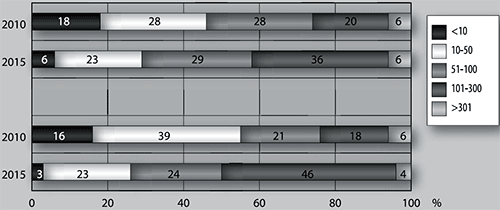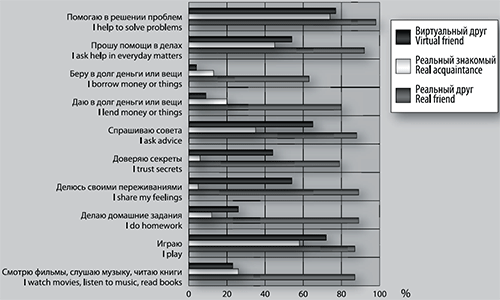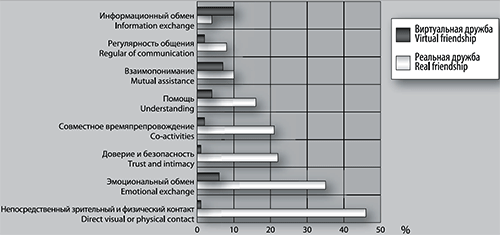Article
Soldatova G.U., Teslavskaya O.I. (2018) Interpersonal relations of Russian adolescents in social networks. National Psychological Journal. 3, 12-22.
Abstract
Background. In the period of adolescence, friendship plays the key role for developing the adolescent personality, for determining their psychological well-being now and for further living. There is lack of data about the actual size of their online friend zone, adolescent perception of real and virtual friendship, and factual features of their relationships with different categories of users, primarily with virtual friends, who adolescents communicate only in the Internet.
Objective. The quantitative research of the online circle of contacts of Russian adolescnts in social media, their perceptions of real and virtual friendship, and regular features of their communication with real friends and acquaintances, and virtual friends.
Design. The survey among adolescents from Moscow, Russia, and Moscow region, Russia, was conducted (N=366, aged 13-16 years old) using the questionnaire of 43 questions about their friend list size and number of online followers; youths’ relationship with real friends and acquaintances, and virtual friends; the method of the unfinished sentences with the following content analysis aimed to investigate adolescent perception of real and virtual friendship. For comparison, we also used data of the All-Russian survey Kids Online II (N=604) conducted by the Foundation for Internet Development (2010).
Results. The results show that 50% of adolescent contacts (aged 15–16) and 43% aged 13–14 outweighs the lower limit of the Dunbar number (100 social connections). Thus, they are almost equivalent to the quantity of social contact of an adult. Friend zone extension occurs due to real friends and acquaintances, and ‘unknown’ virtual friends (whom the adolescent has not seen in real life), hence raising the issue of such relationships’ quality. The results of the content analysis of adolescent answers about differences between real and virtual friendship show that real friendship is more important to them as it contains Direct interpersonal contact (tactile and visual), Emotional exchange, Trust, Co-Activities, Mutual support. Virtual friendship has been characterized through absence, significant lack and/or negative inversion (e.g. from Trust to Mistrust) of these components. Simultaneously, each second youth has virtual friend, whom he/she trusts enough to share private topics, so that such virtual friends play the role of ‘by chance companions’. Adolescents discuss with them life problems and conflicts with parents (35%), real friends and teachers (51–53%), and also their beloved ones (47%).
Conclusion. The number of online social connections among adolescents exceeds the lower limit of the Dunbar range, comparing with similar indicators in adults. Expansion of the virtual circle of communication occurs both at the expense of real friends and acquaintances, and virtual friends unfamiliar to the child in everyday life, which puts the question of the quality of these relations. Virtual friends act in the role of "casual fellow travelers", because with their help adolescents satisfy the needs for intimate contact. This happens even though the children themselves are aware of the disadvantages of online communication compared to offline relationships. The phenomenon of a virtual friend, therefore, occupies one of the key places in the system of interpersonal relations of a modern adolescent and requires further study. On the whole, the phenomena of the ‘unknown friend’ holds one of the key places in the adolescnet system of relationships, thus requiring special research.
Accepted: 09/07/2018
Pages: 12-22
DOI: 10.11621/npj.2018.0302
PDF: Download
Keywords: friendship; adolescent social connections; online communication in adolescence; Dunbar number; online friendship; social media; friends and followers; real and virtual friends;
Available Online 30.09.2018

Fig. 1. The number of «friends» in social networks among adolescents of 13-14 and 15-16 years, as of 2010 and 2016 (%)

Fig. 2. The number of «subscribers» in social networks among adolescents of 13–14 and 15–16 years, as of 2016 (%)

Fig. 3. Major types of joint activities in adolescents with real friends and acquaintances and virtual friends (%)

Fig. 4. Categories of real and virtual friendship, the results of content analysis (% of children who marked the presence of this category)

Fig. 5. Circle of communication of contemporary Russian adolescents in real life and on the Internet
References:
Allen J., Uchino B., & Hafen C.A. (2015) Running with the pack. Teen Peer-Relationship Qualities as Predictors of Adult Physical Health. Psychological Science. 10(26), 1574–1583.
Arerestova, O.N., & Mahmudova, S.Kh. (2018) Subjective presentation of family relations at different levels of awareness (based on adolescence). [Vestnik Moskovskogo universiteta]. Series 14. Psychology, 1, 55–69.
Armsden, G., & Greenberg, M. (1987) The inventory of parent and peer attachment: Individual differences in their relationship to psychological well-being in adolescence. Journal of Youth and Adolescence, 5(16), 427–454.
Brandzaeg, P.B., Heim, J., & Kaare, B. (2010) Bridging and bonding in social network sites – investigating family-based capital. Int. J. Web Based Commun, 6, 231–353.
Brett, L. (1993) Close friendships in adolescence. New Directions for Child Development. 60, (3–22). San Francisco: Jossey-Bass.
Brown, B., & Larson, J. (2009) Peer Relationships in Adolescence. Handbook of Adolescent Psychology. Eds. Lerner R.M., & Steinberg L.
Dunbar, R. (2016) Do online social media cut through the constraints that limit the size of offline social networks? Royal Society Open Science. Retrieved from: http://rsos.royalsocietypublishing.org/content/3/1/150292 (accessed 20.08.2018).
Englund, M., I-Chun, Kuo S., Puig, J., & Collins, A. (2011) Early roots of adult competence. The significance of close relationships from infancy to early adulthood. International Journal of Behavioral Development, 6(35), 490–496.
Freberg, K., Adams, R., McGaughey, K., & Freberg, L. (2010) The rich get richer: online and offline social connectivity predicts subjective loneliness. Media Psychol. Rev. 3.
Gozman, L.Ya. (1987) Psychology of emotional relationships. Moscow, MGU.
Hauser, S., Gerber, E., & Allen, J. (1998) Ego development and attachment: Converging platforms for understanding close relationships. In: Westenberg MP, Blasi A, editors. Personality development: Theoretical, empirical, and clinical implications of Loevinger’s conception of ego development. Mahwah, NJ: Lawrence Erlbaum, 203–217.
Holt-Lunstad, J., Smith, T., & Layton, B. (2010) Social Relationships and Mortality Risk: A meta-analytuc Review. PLoS Med. 7(7). Retrieved from: http://journals.plos.org/plosmedicine/article/file?id=10.1371/journal.pmed.1000316&type=printable (accessed 20.08.2018)
Howes, C. (1996) The earliest friendships. In The company, they keep: friendship in childhood and adolescence. UK: Cambridge University Press, 66–86.
Hennighausen, K.H., Hauser, S.T., Billings, R.L., Schultz, L.H., & Allen, J.P. (2004) Adolescent ego-development trajectories and young adult relationship outcomes. Journal of Early Adolescence, 24, 29–44.
Hinde, R. A. (1995) A suggested structure for a science of relationships. Personal relationships, 2 (1995), 1–15.
Kuruzovic, N. (2015) Characteristics of adolescents friendship relations: a longitudinal study of the quality, length, stability and reciprocity. Facta Universitatis, 2(14), 115–129.
Kon, I.S. (1973) Psychology of youthful friendship. Moscow, Znanie.
Kon, I.S. (1980) Friendship: an ethical and psychological essay. Moscow, Izdatel’stvo politicheskoy literatury.
Mudrik, A.V. (1981) Psychology of Friendship. [Voprosy Psikhologii], 4, 180–182.
Marsh, P., Allen, J., Ho, M., Porter M., & McFarland, F. (2006) The changing nature of adolescent friendships: Longitudinal links with early adolescent ego-development. Journal of Early Adolescence, 26(4), 414–431.
Parker, J., Rubin, K., Erath, S., Wojslawowicz, J., & Buskirk, A. (1995) Peer relationships, child development, and adjustment: A developmental psychopathology perspective. In Developmental Psychopathology: Theory and Method. Eds Dante, Cicchetti and Donald, Cohen. New York: John Wiley & Sons, 421–477.
Prinstein, M., & La Greca, A. (2004) Childhood peer rejection and aggression as predictors of adolescent girls’ externalizing and health risk factors: a 6-year longitudinal study. Journal of Consulting and Clinical Psychology, 72(1), 103–112.
Quan-Haase, A., & Wellman, B. (2004) How does the internet affect social capital? Social capital and information technology. Cambridge, MA: MIT Press, 113–132.
Rice, F., & Dolgin, K. (2010) Psychology of adolescence and adolescence. St. Petersburg, Piter.
Soldatova, G.U. (2013) Digital competence of teenagers and parents. The results of the All-Russian study. G.U. Soldatova, Т.А. Nestik, E.I. Rasskazova, & E.Yu. Zotova. Moscow, Fond Razvitiya Internet. 143.
Soldatova, G. Children of Russia online. The results of the EU Kids Online 2nd international project in Russia. G.U. Soldatova, E.I. Rasskazova, E.Yu. Zotova et al. [Deti Rossii Onlayn]. Retrieved from: http://detionline.com/assets/files/helpline/Final_Report_05-29-11.pdf (accessed August 20, 2018).
Suhomlinsky, V.A. (1971) The birth of a citizen. Moscow, Molodaya gvardiya.
Voiskounsky, A.E. (2010) Internet Addiction in the Context of Positive Psychology. Psychology in Russia: State of the Art, 3, 541–549.
Wang, H., & Wellman, B. (2010) Social connectivity in America: changes in adult friendship network size from 2002 to 2007. Am. Behav. Sci, 53, 1148–1169.
Wellman, B., Quan-Haase, A., Witte, J., & Hampton, K. (2001) Does the Internet increase, decrease or supplement social capital? Social networks, participation and community commitment. Am. Behav. Sci., 45, 436–465.
Zhurina, M.A. (2015-2016) "Everyone has a girlfriend, but I do not have any yet." How do adolescents get to know the Internet, on what purpose and whom they are looking for. [Deti v informatsionnom obshchestve], 23, 30–33.
Zimmermann, P. (2004) Attachment representations and characteristics of friendship relations during adolescence. Journal of Experimental Child Psychology, 88, 83–101.For citing this article:
Soldatova G.U., Teslavskaya O.I. (2018) Interpersonal relations of Russian adolescents in social networks. National Psychological Journal. 3, 12-22.


